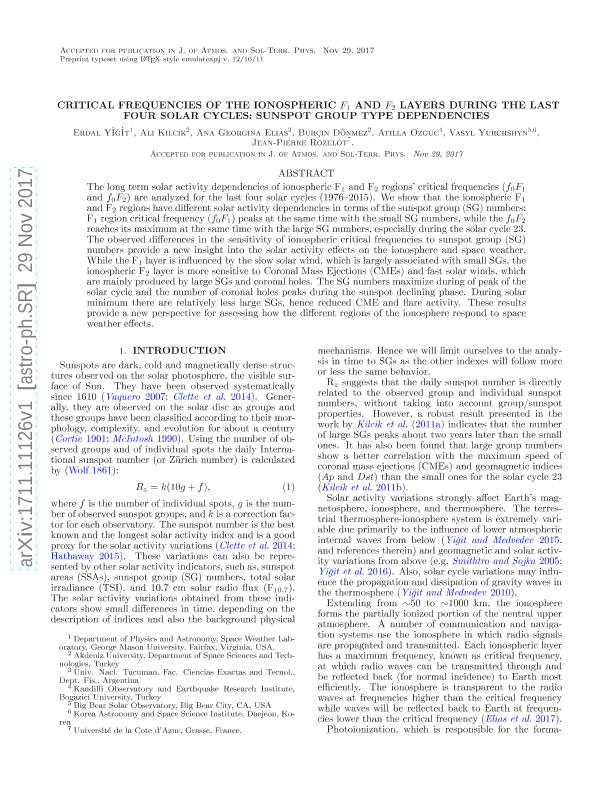Artículo
Critical frequencies of the ionospheric F1 and F2 layers during the last four solar cycles: Sunspot group type dependencies
Yiğit, Erdal; Kilcik, Ali; Elias, Ana Georgina ; Dönmez, Burçin; Ozguc, Atila; Yurchshyn, Vasyl; Rozelot, Jean Pierre
; Dönmez, Burçin; Ozguc, Atila; Yurchshyn, Vasyl; Rozelot, Jean Pierre
 ; Dönmez, Burçin; Ozguc, Atila; Yurchshyn, Vasyl; Rozelot, Jean Pierre
; Dönmez, Burçin; Ozguc, Atila; Yurchshyn, Vasyl; Rozelot, Jean Pierre
Fecha de publicación:
06/2018
Editorial:
Elsevier
Revista:
Journal of Atmospheric and Solar-Terrestrial Physics
ISSN:
1364-6826
Idioma:
Inglés
Tipo de recurso:
Artículo publicado
Clasificación temática:
Resumen
The long term solar activity dependencies of ionospheric F1 and F2 regions’ critical frequencies (f0F1 and f0F2) are analyzed for the last four solar cycles (1976–2015). We show that the ionospheric F1 and F2 regions have different solar activity dependencies in terms of the sunspot group (SG) numbers: F1 region critical frequency (f0F1) peaks at the same time with the small SG numbers, while the f0F2 reaches its maximum at the same time with the large SG numbers, especially during the solar cycle 23. The observed differences in the sensitivity of ionospheric critical frequencies to sunspot group (SG) numbers provide a new insight into the solar activity effects on the ionosphere and space weather. While the F1 layer is influenced by the slow solar wind, which is largely associated with small SGs, the ionospheric F2 layer is more sensitive to Coronal Mass Ejections (CMEs) and fast solar winds, which are mainly produced by large SGs and coronal holes. The SG numbers maximize during of peak of the solar cycle and the number of coronal holes peaks during the sunspot declining phase. During solar minimum there are relatively less large SGs, hence reduced CME and flare activity. These results provide a new perspective for assessing how the different regions of the ionosphere respond to space weather effects.
Palabras clave:
IONOSPHERE
,
IONOSPHERIC CRITICAL FREQUENCIES
,
SOLAR CYCLE
,
SUNSPOTS
Archivos asociados
Licencia
Identificadores
Colecciones
Articulos (INFINOA)
Articulos de INSTITUTO DE FISICA DEL NOROESTE ARGENTINO
Articulos de INSTITUTO DE FISICA DEL NOROESTE ARGENTINO
Citación
Yiğit, Erdal; Kilcik, Ali; Elias, Ana Georgina; Dönmez, Burçin; Ozguc, Atila; et al.; Critical frequencies of the ionospheric F1 and F2 layers during the last four solar cycles: Sunspot group type dependencies; Elsevier; Journal of Atmospheric and Solar-Terrestrial Physics; 171; 6-2018; 157-163
Compartir
Altmétricas



